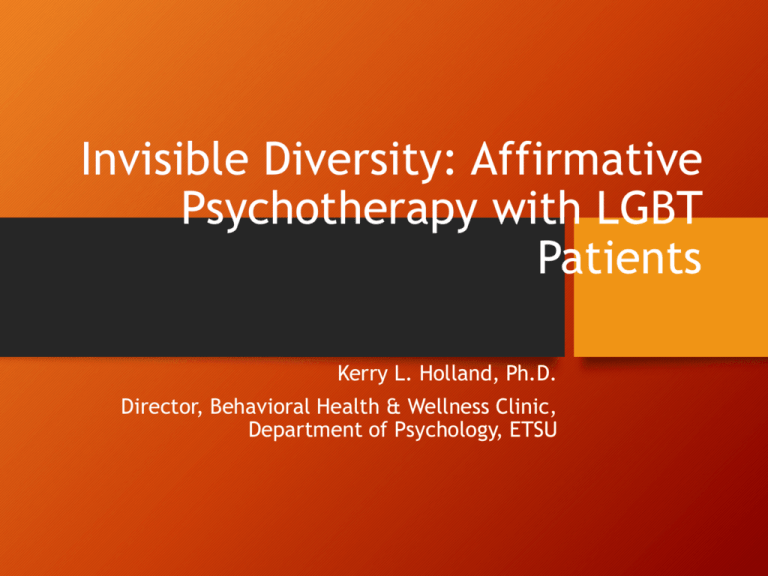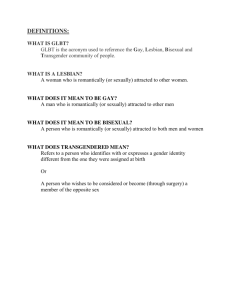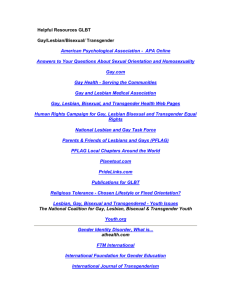
Invisible Diversity: Affirmative
Psychotherapy with LGBT
Patients
Kerry L. Holland, Ph.D.
Director, Behavioral Health & Wellness Clinic,
Department of Psychology, ETSU
Learning Objectives
• Participants will be able to:
• Describe APA Standards for working with LGBT
patients
• Describe WPATH Standards of Care for work
with transgender patients
• Identify strategies to create an affirmative
environment for LGBT patients
• Describe the coming out process
I’m not an expert
But I am very interested and
always striving to do better.
We’ll do this together.
• “They’re just like everybody else
• “I don’t treat them any differently”
Ethical Principles & Code of
Conduct
• Standard 2: Competence(b) Where scientific or
professional knowledge in the discipline of psychology
establishes that an understanding of factors
associated with age, gender, gender identity, race,
ethnicity, culture, national origin, religion, sexual
orientation, disability, language or socioeconomic
status is essential for effective implementation of
their services or research, psychologists have or
obtain the training, experience, consultation or
supervision necessary to ensure the competence of
their services, or they make appropriate referrals,
except as provided in Standard 2.02, Providing
Services in Emergencies.
BOE Psychology 9/13 Rule
revision
• Rule 1180-1-.08 (1)(f) is deleted and amended to read:
Three (3) CE hours shall pertain to cultural diversity as
specifically noted in the title, description of objectives,
or curriculum of the presentation, symposium, workshop,
seminar, course or activity. Cultural diversity includes
aspects of identity stemming from age, disability, gender,
race/ethnicity, religious/spiritual orientation, sexual
orientation, socioeconomic status, and other cultural
dimensions. The topic of the presentation, symposium,
workshop, seminar, course or activity need not be on
cultural diversity, but one of the objectives or
descriptions of the topics covered, shall clearly indicate
attention to the cultural diversity.
CE Requirements
CE audits in 2015 for 2 previous yrs
will not require compliance
CE audits in 2016 will
APA Practice Guidelines for LGB
Clients
• Guidelines revised because of advances in
science and new socio/cultural pressures to
re-pathologize homosexuality
• Developed in response to survey in early 90’s
Attitudes Toward Homosexuality and
Bisexuality
• 1. Psychologists strive to understand the effects
of stigma (i.e., prejudice, discrimination, and
violence) and its various contextual
manifestations in the lives of lesbian, gay, and
bisexual people.
• 2. Psychologists understand that lesbian, gay, and
bisexual orientations are not mental illnesses.
• 3. Psychologists understand that same-sex
attractions, feelings, and behavior are normal
variants of human sexuality and that efforts to
change sexual orientation have not been shown
to be effective or safe.
• 4. Psychologists are encouraged to recognize how
their attitudes and knowledge about lesbian, gay,
and bisexual issues may be relevant to assessment
and treatment and seek consultation or make
appropriate referrals when indicated.
• 5. Psychologists strive to recognize the unique
experiences of bisexual individuals.
• 6. Psychologists strive to distinguish issues of
sexual orientation from those of gender identity
when working with lesbian, gay, and bisexual
clients.
Relationships and Families
• 7. Psychologists strive to be knowledgeable
about and respect the importance of lesbian,
gay, and bisexual relationships.
• 8. Psychologists strive to understand the
experiences and challenges faced by lesbian,
gay, and bisexual parents.
• 9. Psychologists recognize that the families of
lesbian, gay, and bisexual people may include
people who are not legally or biologically
related.
• 10. Psychologists strive to understand the ways
in which a person's lesbian, gay, or bisexual
orientation may have an impact on his or her
family of origin and the relationship with that
family of origin.
Issues of Diversity
• 11. Psychologists strive to recognize the
challenges related to multiple and often
conflicting norms, values, and beliefs faced by
lesbian, gay, and bisexual members of racial
and ethnic minority groups.
• 12. Psychologists are encouraged to consider
the influences of religion and spirituality in
the lives of lesbian, gay, and bisexual persons.
• 13. Psychologists strive to recognize cohort
and age differences among lesbian, gay, and
bisexual individuals.
• 14. Psychologists strive to understand the
unique problems and risks that exist for
lesbian, gay, and bisexual youth.
• 15. Psychologists are encouraged to recognize
the particular challenges that lesbian, gay, and
bisexual individuals with physical, sensory, and
cognitive-emotional disabilities experience.
• 16. Psychologists strive to understand the
impact of HIV/AIDS on the lives of lesbian, gay,
and bisexual individuals and communities.
Economic and Workplace Issues
• 17. Psychologists are encouraged to consider
the impact of socioeconomic status on the
psychological well being of lesbian, gay, and
bisexual clients.
• Guideline 18. Psychologists strive to
understand the unique workplace issues that
exist for lesbian, gay, and bisexual individuals.
Education and Training
• 19. Psychologists strive to include lesbian, gay,
and bisexual issues in professional education
and training.
• 20. Psychologists are encouraged to increase
their knowledge and understanding of
homosexuality and bisexuality through
continuing education, training, supervision,
and consultation.
Research
• 21. In the use and dissemination of research
on sexual orientation and related issues,
psychologists strive to represent results fully
and accurately and to be mindful of the
potential misuse or misrepresentation of
research findings.
APA Task Force on Guidelines for
Practice with Transgender and
Gender Non-Conforming Clients
• Met in Atlanta in 2012 for first in-person
meeting
• Prepared a timeline for developing Guidelines
WPATH Standards of Care
• Transgender: umbrella term for persons whose
gender identity, gender expression or behavior
does not conform to that typically associated
with the sex to which they were assigned at
birth (APA.org)
• Gender nonconformity: the extent to which a
person’s gender identity, role, or expression
differs from the cultural norms prescribed for
people of a particular sex (Institute of
Medicine, 2011)
• Gender dysphoria: discomfort or distress that
is caused by a discrepancy between a person’s
gender identity and that person’s sex assigned
at birth (and the associated gender role
and/or primary and secondary sex
characteristics) (Fisk, 1974; Knudson,
DeCuypere, & Bockting, 2010b).
• A disorder is a description of something with
which a person might struggle, not a
description of the person or the person’s
identity.
• Thus, transsexual, transgender, and gendernonconformingindividuals are not inherently
disordered. Rather, the distress of gender
dysphoria, when present, is the concern that
might be diagnosable and for which various
treatment options are available.
Treatment for Gender Dysphoria
• Hormone therapy and surgery have been found
to be medically necessary to alleviate gender
dysphoria in many people (American Medical
Association, 2008; Anton, 2009; World
Professional Association for Transgender
Health, 2008).
• While many individuals need both hormone
therapy and surgery to alleviate their gender
dysphoria, others need only one of these
treatment options and some need neither
(Bockting & Goldberg, 2006; Bockting,
2008;Lev, 2004).
• With the help of psychotherapy, some
individuals integrate their trans or crossgender feelings into the gender role they were
assigned at birth and do not feel the need to
feminize or masculinize their body.
• For others changes in gender role and
expression are sufficient to alleviate gender
dysphoria (Coleman et al., 2011)
Definition of Terms
•
•
•
•
•
•
•
•
Lesbian
Gay
Down-low, MSM
Transgender
Transexual
Queer/Questioning
Intersex
Heterosexism/heterosexual privelege
Terms to Avoid
• lifestyle: A vague, often politically charged
term sometimes used to describe the lives of
lesbian, gay, bisexual and transgender people.
• practicing: Use “sexually active” as a modifier
in circumstances when public awareness of an
individual’s behavior is germane.
• sexual preference: Sexual orientation is
preferred to describe innate sexual attraction.
Stages of Coming Out (Cass, ‘79)
(Stage 1: Identity Formation)
• Identity Confusion- “my behavior may be
called homosexual”, incongruency between
perception of behavior & perception of self
• Attempts to resolve this confusion:
• Correct & acceptable
• Correct & undesirable – inhibition of behaviors,
restriction & control of information on homosexuality,
denial that information is relevant
• Incorrect & undesirable
Stage 2: Identity Comparison
• Begins to accept that may be homosexual in
identity, but also begins to become aware of
perceptions of others toward homosexuality –
stigma/shame; may feel alienated
• Very often lack of identifiable positive role
models
Four approaches to reducing
feelings of alienation at this stage
• Individual reacts positively to the idea of being
different
• Accepts homosexual meaning of behavior, but
finds the self-image undesirable
• Accepts self as homosexual and the behavior as
homosexual, but views the behavior as
undesirable. Lives asexual life. Successful
inhibition leads to identity foreclosure.
• Self and behavior viewed as undesirable & wishes
to change both
Stage 3: Identity Tolerance
• Self-image has turned further away from
heterosexual and more toward homosexual.
• Feelings of alienation may be accentuated, begins
to seek out other homosexuals – gay subculture;
tolerates rather than accepts identity
• Positive contacts make other homosexuals appear
more significant & more favorable; comes to feel
more positively about self
• Unrewarding contacts result in devaluation of gay
subculture more likely to result->> self-hatred
Stage 4: Identity Acceptance
• Increasing contact with gay community,
allowing the individual to feel the impact of
the subculture that validate and normalize
homosexuality as an identity and way of life.
• Individual accepts rather than tolerates a gay
self-image.
• Discovers preferences for gay social contexts
>>> developing friendships with in gay
community.
Gay subculture increasingly
important
• Degree of “outness” – out publicly & privately;
or not out publicly
• Totally “out” – will increase internal tension –
more aware of external pressures
• Partially “out” – “fitting in” or “passing”
Stage 5: Identity Pride
• Individual’s awareness of incongruency of self
perception as acceptable and society’s
rejection increases
• Manages this incongruency by devaluing
heterosexuals relative to homosexuals
• May experience increase in anger out of
frustration & alienation
• Combination of anger & pride creates
“activist”
Stage 6: Identity Synthesis
• Decreases in viewing “us” vs “them”;
“gay=good; straight=bad”
• More flexibility in view of self, others,
outness, responses to negative views of others
is dampened a bit
Shame Resilience Theory
• Brene Brown (2006) Based on her work with
women and shame – see some applications for
working with individuals struggling with
coming out
Terms
• Shame: “intensely painful feeling or
experience of believing we are flawed and
therefore unworthy of acceptance and
belonging”
• Shame is a psycho-social-cultural construct
Main Concern for Individuals
• Feelings of being trapped, powerless, and
isolated
• Trapped – expectations and options
• Powerless – shame produces overwhelming, painful
feelings of confusion, fear, anger & judgment,
and/or need to hide; making it difficult to identify
& act with consciousness on choices that would
facilitate change
• Isolated – results from feeling trapped & powerless
Shame Web
• Layered, conflicting, and competing
expectations
• Expectations often imposed, enforced or
expressed by individuals & groups, partners,
friends, coworkers etc.
• Reinforced by media
Shame Resilience
Critical Awareness
Speaking Shame
Shame Triggers
• Unwanted identities
• SRT connected to Relational-Cultural theory
Case Study: Bob, age 61
• Coming out, limited sexual experience, no
relationship history, extremely isolated,
limited friendships
• “I want love in my life”
• “I don’t want to be gay”
Coming Out
• http://www.youtube.com/watch?v=IEqB6Y8FjSg
Sexually Diverse Individuals
• Face common struggles with societal
oppression
• Face similar difficulty developing positive
individual identities and healthy communities
within that oppression
• As with other minorities, deserving of
sensitivity when treating them.
48
Human Sexuality…
• Believed to be characterized by a continuum
rather than discrete categories
• Biological, physiological & genetic
contributions combine to determine an
individual’s ascribed or claimed sex
Whereas…
• Gender expression, sexuality, & sexual
behavior are fluid, dynamic processes in which
that person engages (Fausto-Sterling, 1998 in
Bieschke, Perez, DeBord 2007)
Aspects of sexual identity can
include…
• Affectional & intimate preferences &
attachments, gender identity, social sex roles,
sexual behaviors, erotic fantasies, sexual &
emotional arousal patterns, self-identification,
lifestyle, community, disclosure, political
commitments, social preferences, &
consistency or change over time (Bieschke,
Perez, and DeBord, 2007)
Behaviors and Identity
• May self-identify as gay and not be sexual
exclusively with same sex or at all
• May be sexual with same sex, but not selfidentify as gay
53
Bisexual Behavior
• In men, estimates range: 20.3% have ever had a
same sex experience, 9.1% have had such
experience since puberty, 4.9%-6.7% have had such
experience since age 18 or 20
• Less than 1% of U.S. men self-identify as bisexual
(Rust, 2000c) in Bieschke, Perez, & DeBord (2007).
• 75% - 90% of lesbians report having engaged in
heterosexual activity (Rankow, 1995)
LGBT & Racial/Ethnic Diversity
• http://www.youtube.com/watch?v=DKtAbOdWyqM
Bisexual Orientation
• http://www.youtube.com/watch?v=4SSTqeVO4Go
Health Risks Associated With
Being a Sexual Minority
•
•
•
•
Avoidance of preventive/routine medical care
Stress of being a sexual minority
Sexual behavior
Aging presents unique concerns
Stress Related Risks Both Sexes
• Increased mental distress, emotional disorders,
relationship issues, internalized homophobia
• Substance use and/or abuse (esp. young gay men)
• Suicide
• Victims of violence (hate crimes)
• Higher rates of tobacco use
• Certain cancers: due to suppression of immune
system as a result of stress, such as melanoma
Risks for Lesbians
• Lesbians have higher occurrence of obesity
and those associated health risks
• Increased risk of breast and gynecological
cancers may be due to obesity, nulliparity and
lack of early screening
• Domestic violence
Risks for Gay Men
• Prostate cancer
• Anal cancer
• Eating disorders
LGBT Youth
• Are at an even greater risk of homophobic
related violence than their older peers
• Disproportionately represented in the runaway
or “throwaway” youths
• Increased risk of suicide attempts and
completions
LGB Adults who reported high rates
of parental rejection as teens
• Were 8.4 times more likely to have attempted
suicide
• 5.9 times more likely to report high levels of
depression
• 3.4 times more likely to use illegal drugs
• 3.4 times more likely to have unprotected sex
than LGB peers who reported no or low levels
of rejection (Peds, vol. 123, no.1)
Transgender Individuals
• Experience many of the same health risks
• Additionally, may experience greater
occurrences of violence, rejection, or
harassment by others
Cultural Competence in
Practice…
• Do your forms presume heterosexuality, and distinct
gender?
• Unisex restrooms make it easier for transgender
patients.
• Asking the patient, “How do you prefer to be
addressed?”
• Create a more comfortable waiting area; special days of
observance: Pride Week, National Coming Out Day,
Transgender Day of Remembrance
In the consulting room...
• Use of safe zone stickers, lapel pins, artwork.
• During history taking, avoid heterosexist
language: couple, partner, allow that sexual
behavior can include same sex, both sexes,
not presuming someone who has children is
straight or that someone who is gay doesn’t
have/want children
Check It Out
• Gay & Lesbian Medical Association:
• www.glma.org
• www.fenwayhealth.org Click on Fenway
Institute
• www.apa.org







